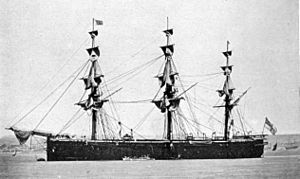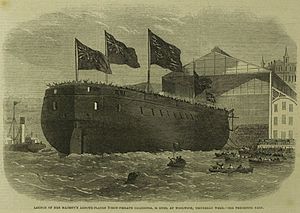HMS Caledonia (1862) facts for kids
 |
|
Quick facts for kids History |
|
|---|---|
| Name | HMS Caledonia |
| Namesake | Caledonia |
| Builder | Woolwich Dockyard |
| Laid down | 10 October 1860 |
| Launched | 24 October 1862 |
| Completed | July 1865 |
| Fate | Broken up, 1886 |
| General characteristics | |
| Class and type | Prince Consort-class ironclad |
| Displacement | 6,832 long tons (6,942 t) |
| Length |
|
| Beam |
|
| Draught |
|
| Propulsion |
|
| Sail plan | Single-topsail barque, sail area 25,000 sq ft (2,300 m2) |
| Speed | |
| Complement | 605 |
| Armament |
|
| Armour | Battery and belt: 4.5 in (110 mm) amidships and 3 in (76 mm) fore and aft |
HMS Caledonia was a powerful warship from the past. She was an "ironclad," meaning she had strong metal armor to protect her. She started as a large wooden ship called a "steam ship of the line" but was changed during building into an "armoured frigate." This made her a very strong and important ship for the Royal Navy.
Life of the HMS Caledonia
HMS Caledonia was finished in July 1865. This was a bit late because her main guns took a while to arrive. Once her guns were installed, she joined the Mediterranean Fleet. She became the very first armoured flagship for the Royal Navy. A flagship is the ship where the fleet's commander stays.
Changes and New Roles
In 1866, Caledonia was taken out of service for a short time. Workers added a new upper deck, called a poop deck, to the ship. After these changes, she became the flagship of the Channel Fleet until 1867. Then, she was taken out of service again to get new weapons.
From 1869 to 1872, HMS Caledonia was once again the flagship of the Mediterranean Fleet. She took over this role from HMS Victoria.
Incidents at Sea
In July 1871, Caledonia accidentally hit the ground near Santorini, Greece. Luckily, she was pulled free and taken to Malta for repairs.
Two years later, on June 15, 1873, Caledonia crashed into another British ship called Hogton Tower. This happened near St. Alban's Head, Dorset. The Hogton Tower was badly damaged at the front. Caledonia was able to tow the damaged ship to Spithead, Hampshire.
At the time of the collision, Caledonia was working as a Coastguard vessel in Birkenhead, Cheshire. She was sailing to Portsmouth, Hampshire, for a special inspection by the Shah of Persia.
End of Service
After these events, Caledonia was taken out of service at Plymouth. She stayed there until she was sold on September 30, 1886. This marked the end of her time as a Royal Navy ship.


